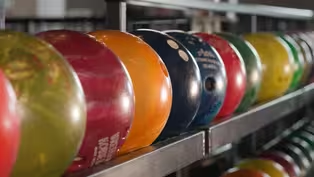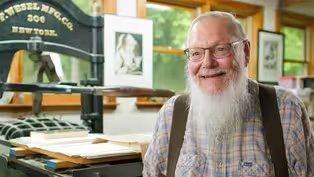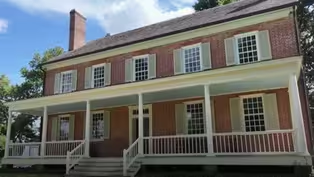
All Hams on Deck
Clip: Season 31 Episode 1 | 6m 23sVideo has Closed Captions
A program called All Hams on Deck where people learn first-hand curing country hams.
A program called All Hams on Deck where people learn first-hand the Kentucky tradition of curing country hams.
Problems playing video? | Closed Captioning Feedback
Problems playing video? | Closed Captioning Feedback
Kentucky Life is a local public television program presented by KET
You give every Kentuckian the opportunity to explore new ideas and new worlds through KET. Visit the Kentucky Life website.

All Hams on Deck
Clip: Season 31 Episode 1 | 6m 23sVideo has Closed Captions
A program called All Hams on Deck where people learn first-hand the Kentucky tradition of curing country hams.
Problems playing video? | Closed Captioning Feedback
How to Watch Kentucky Life
Kentucky Life is available to stream on pbs.org and the free PBS App, available on iPhone, Apple TV, Android TV, Android smartphones, Amazon Fire TV, Amazon Fire Tablet, Roku, Samsung Smart TV, and Vizio.
Providing Support for PBS.org
Learn Moreabout PBS online sponsorshipBut first, back before refrigerators ever existed, if you wanted to preserve meats, you had to salt and cure them.
That's where the tradition of Kentucky country ham started.
Now, commercial operations got involved around the 1900s, and at that point, the tradition of hand rubbing a spice blend on a ham and hanging it in a barn started to decline.
But two men in Lexington are aiming to keep the tradition alive, teaching a hundred or so folks every year how to do it.
It truly is an operation that requires, as the name says, All Hams on Deck.
Even before Kentucky was a state, settlers who came here from Virginia brought along the tradition of salt-curing hams.
It was the only way they had to preserve meat, especially pork.
But as with many traditions, industrialization took over, and the practice slowly began to disappear.
That's where Steven Clem and John McDonald IV come in.
Hand-cured ham was a tradition in their families, and they wanted to keep that alive.
That's why they started the All Hams on Deck program.
It's a chance for people to create their own ham that they can then age for a year or two.
It all kicks off in January.
Stephen says that's the one month out of the year when ham prices are usually at their lowest.
A hundred or so people gather at Clem's refrigerated meats in Lexington to start the process.
It begins with a simple mix of kosher salt, brown sugar, and potassium nitrate.
Everybody gets a ham and some gloves, and then the work begins.
We have a cure mixture from it.
And when he says you work the hams, you're basically taking that cure and rubbing it into the ham.
So, it's a manual labor job.
From there, we put them into our ham tubs and take them back to our cooler.
And then, we come back 10 days later and do the exact same process again.
Again, that's what we call our insurance step to make sure that it is fully cured and that cure gets down to the bone because it's pulling out moisture from the cure.
And then, we come back a month later, and that's when the pillowcase happens.
We put some brown paper sacks over and put them in a pillowcase, and then it finds a home in a barn or a garage or an attic or something like that.
It's gonna hang for at least a year or two.
So, I want that to be as safe as it can be from all any pests.
So, two years from now, when I unwrap this, how different is this gonna look?
Well, we are at probably 20 pounds right now.
And next year, it'll probably go down to about 16 pounds.
In two years, it'll probably be down about 13 or 14.
Oh, wow.
So, it'll continue to purge moisture through that whole time.
If everybody does what they do and we do it right, that ham that you're working on could very well be at your Christmas dinner.
So, put the extra effort into it, and we do it right, and you'll get to enjoy and brag about the finished product when you get done.
The way you finish the product depends on how long you age it.
After two years, like the ham Steven brought for us to try, you can cut away the skin and the fat cap and eat it right away.
So, this is two-year Kentucky ham.
That looks like a prosciutto.
It really does.
Gentlemen, see what we got.
That's really good.
It's very good.
It does really taste like a prosciutto.
Now, full disclosure, I am not a big ham fan, but I loved this.
It really did taste like prosciutto I'd had in Spain.
You can also eat the ham after just one year, but that requires more work, like what Kerri Richardson did after she participated in the All Hams on Deck program in 2023.
After a year, Carrie washed and soaked her ham in water for several hours to dry out some of the salt and then cooked it at a low temperature for several hours.
She and her family were very pleased with the results.
Tell me how you got into this.
How did you first become a ham fan?
[Laughs] I grew up in Kentucky.
That's how I became a ham fan.
I just have strong memories of eating it a lot when I was growing up.
My grandma would make big ham steaks for Christmas morning breakfast, you know, in the skillet on the stove, and my mom would fix it and leave some out for my dad, who worked late.
And more often than not, I would eat all of the ham before he got home.
For more than 100 years, there's been a meat sciences program at the University of Kentucky.
That's where we found Dr.
Gregg Rentfrow.
He says he sees young people in particular becoming more interested in foods enjoyed by past generations.
You need to learn your heritage.
You need to learn your food heritage as well.
You know, and I think, again, Kentucky country ham, they go hand in hand.
And I think we're getting into a generation that's wanting to learn more about where they come from, learn more about what their culture is here in the southeast, and learn more about what their culture is here in Kentucky.
And so, it is, on a few winter Saturday mornings, people come together to practice an art their ancestors had to do out of necessity.
It's a throwback to a time before modern conveniences, when feeding your family didn't mean jumping in your car to go to a local restaurant or store.
That's not another trip to the grocery store.
This is something that you work on year-round.
And back in the day, that's how you fed your family.
You had to find a way to cure your meat for the summertime to preserve it so you had something to eat, and I kind of look at it that way.
It's kind of like growing a vegetable garden.
A lot of people don't do that anymore.
They go to the farmers' market, or they go to the grocery store.
And this is something that I hope the generations pick up on.
If we don't make a concerted effort to remember and preserve those, they disappear.
I don't know what else we've already disappeared from our Kentucky history of foodways, but I know there are some things that are probably gone already.
So, even though I didn't grow up producing this, if I can be part of, you know, retelling the story, I wanna be able to do that.
Video has Closed Captions
Clip: S31 Ep1 | 7m 2s | Chip visits the oldest bowling alley in the state, Vernon Lanes. (7m 2s)
Bound by Art: The Larkspur Community
Video has Closed Captions
Clip: S31 Ep1 | 7m 36s | Nestled along Sawdrige Creek in Owen County, you can find a special place for Kentucky letters. (7m 36s)
Video has Closed Captions
Clip: S31 Ep1 | 3m 1s | Chip visits Locust Grove to learn more about the historic home. (3m 1s)
Providing Support for PBS.org
Learn Moreabout PBS online sponsorshipSupport for PBS provided by:
Kentucky Life is a local public television program presented by KET
You give every Kentuckian the opportunity to explore new ideas and new worlds through KET. Visit the Kentucky Life website.
















